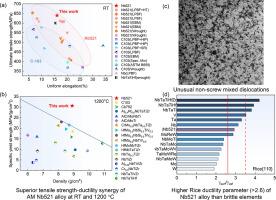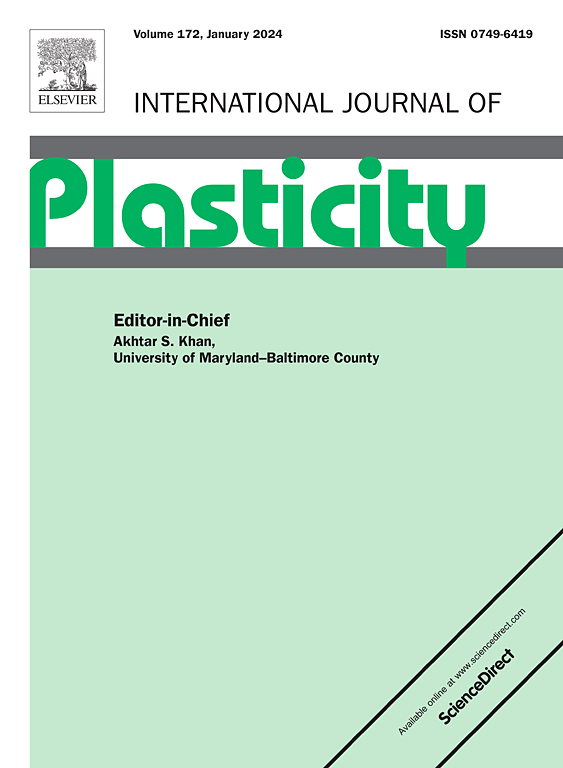Strong yet ductile carbide-strengthened niobium alloy fabricated by laser powder bed fusion
IF 12.8
1区 材料科学
Q1 ENGINEERING, MECHANICAL
引用次数: 0
Abstract
Additive manufacturing (AM) of refractory alloys and high-entropy alloys (RHEAs) are gaining increasing interest due to their superior high-temperature strength and low buy-to-fly ratio. However, most of refractory alloys and RHEAs suffered from room temperature (RT) brittleness and hence severe cracking during AM. Here we report the strong yet ductile carbide-strengthened niobium alloy (so-called Nb521) fabricated by laser powder bed fusion (LPBF). The LPBF Nb521 alloy showcases excellent tensile strength-ductility at RT and outstanding specific yield strength at 1200 °C, as compared to other promising niobium alloys and RHEAs. The LPBF Nb521 alloy exhibits hierarchical microstructures at various length scales, including irregular-shaped grains, nano-scale dispersed carbides and carbides-decorated low/high-angle grain boundaries. Transmission electron microscopy investigations revealed that the good tensile ductility originates from movement of unusually predominant mixed dislocations. Density functional theory calculations uncovered potential reasons for the good ductility, i.e., higher Rice ductility parameter and lower unstable stacking fault energies than brittle elements. Further analyses pointed out the reasons of high strength of the LPBF niobium alloy and potential directions for pursuing even higher strength. Consequently, this study not only deepens the understanding of deformation mechanisms of carbide-strengthened niobium alloys, but also provides a reference for further design of strong yet ductile refractory alloys.


激光粉末床熔合制备高韧性碳化物强化铌合金
耐火合金和高熵合金(RHEAs)的增材制造(AM)由于其优越的高温强度和低采购比而受到越来越多的关注。然而,在AM过程中,大多数耐火合金和RHEAs都存在室温脆性,从而导致严重的开裂。本文报道了采用激光粉末床熔合(LPBF)法制备的强韧性碳化物强化铌合金(Nb521)。与其他有前途的铌合金和RHEAs相比,LPBF Nb521合金在室温下具有优异的抗拉强度和延展性,在1200°C时具有优异的比屈服强度。LPBF Nb521合金在不同长度尺度上表现出分层组织,包括不规则形状的晶粒、纳米尺度的分散碳化物和碳化物装饰的低/高角度晶界。透射电镜研究表明,良好的拉伸延展性源于异常占优势的混合位错的运动。密度泛函理论计算揭示了具有足够延性的潜在原因,即相对于脆性元件,具有较高的Rice延性参数和较低的不稳定层错能。进一步分析了LPBF合金高强度的原因,指出了追求更高强度的可能方向。因此,本研究不仅加深了对碳化物强化铌合金变形机理的认识,而且为进一步设计强而韧性的铌合金提供了参考。
本文章由计算机程序翻译,如有差异,请以英文原文为准。
求助全文
约1分钟内获得全文
求助全文
来源期刊

International Journal of Plasticity
工程技术-材料科学:综合
CiteScore
15.30
自引率
26.50%
发文量
256
审稿时长
46 days
期刊介绍:
International Journal of Plasticity aims to present original research encompassing all facets of plastic deformation, damage, and fracture behavior in both isotropic and anisotropic solids. This includes exploring the thermodynamics of plasticity and fracture, continuum theory, and macroscopic as well as microscopic phenomena.
Topics of interest span the plastic behavior of single crystals and polycrystalline metals, ceramics, rocks, soils, composites, nanocrystalline and microelectronics materials, shape memory alloys, ferroelectric ceramics, thin films, and polymers. Additionally, the journal covers plasticity aspects of failure and fracture mechanics. Contributions involving significant experimental, numerical, or theoretical advancements that enhance the understanding of the plastic behavior of solids are particularly valued. Papers addressing the modeling of finite nonlinear elastic deformation, bearing similarities to the modeling of plastic deformation, are also welcomed.
 求助内容:
求助内容: 应助结果提醒方式:
应助结果提醒方式:


